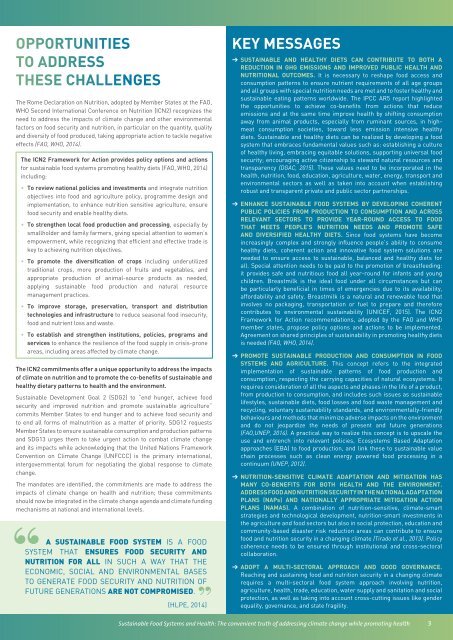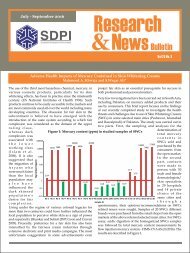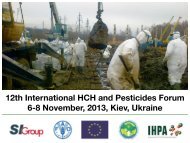SUSTAINABLE FOOD SYSTEMS AND HEALTH
EXE_2_Sustainable_Food_systems_and_health
EXE_2_Sustainable_Food_systems_and_health
Create successful ePaper yourself
Turn your PDF publications into a flip-book with our unique Google optimized e-Paper software.
OPPORTUNITIES<br />
TO ADDRESS<br />
THESE CHALLENGES<br />
The Rome Declaration on Nutrition, adopted by Member States at the FAO,<br />
WHO Second International Conference on Nutrition (ICN2) recognizes the<br />
need to address the impacts of climate change and other environmental<br />
factors on food security and nutrition, in particular on the quantity, quality<br />
and diversity of food produced, taking appropriate action to tackle negative<br />
effects (FAO, WHO, 2014).<br />
The ICN2 Framework for Action provides policy options and actions<br />
for sustainable food systems promoting healthy diets (FAO, WHO, 2014)<br />
including:<br />
• To review national policies and investments and integrate nutrition<br />
objectives into food and agriculture policy, programme design and<br />
implementation, to enhance nutrition sensitive agriculture, ensure<br />
food security and enable healthy diets.<br />
• To strengthen local food production and processing, especially by<br />
smallholder and family farmers, giving special attention to women’s<br />
empowerment, while recognizing that efficient and effective trade is<br />
key to achieving nutrition objectives.<br />
• To promote the diversification of crops including underutilized<br />
traditional crops, more production of fruits and vegetables, and<br />
appropriate production of animal-source products as needed,<br />
applying sustainable food production and natural resource<br />
management practices.<br />
• To improve storage, preservation, transport and distribution<br />
technologies and infrastructure to reduce seasonal food insecurity,<br />
food and nutrient loss and waste.<br />
• To establish and strengthen institutions, policies, programs and<br />
services to enhance the resilience of the food supply in crisis-prone<br />
areas, including areas affected by climate change.<br />
The ICN2 commitments offer a unique opportunity to address the impacts<br />
of climate on nutrition and to promote the co-benefits of sustainable and<br />
healthy dietary patterns to health and the environment.<br />
Sustainable Development Goal 2 (SDG2) to “end hunger, achieve food<br />
security and improved nutrition and promote sustainable agriculture”<br />
commits Member States to end hunger and to achieve food security and<br />
to end all forms of malnutrition as a matter of priority. SDG12 requests<br />
Member States to ensure sustainable consumption and production patterns<br />
and SDG13 urges them to take urgent action to combat climate change<br />
and its impacts while acknowledging that the United Nations Framework<br />
Convention on Climate Change (UNFCCC) is the primary international,<br />
intergovernmental forum for negotiating the global response to climate<br />
change.<br />
The mandates are identified, the commitments are made to address the<br />
impacts of climate change on health and nutrition; these commitments<br />
should now be integrated in the climate change agenda and climate funding<br />
mechanisms at national and international levels.<br />
A <strong>SUSTAINABLE</strong> <strong>FOOD</strong> SYSTEM IS A <strong>FOOD</strong><br />
SYSTEM THAT ENSURES <strong>FOOD</strong> SECURITY <strong>AND</strong><br />
NUTRITION FOR ALL IN SUCH A WAY THAT THE<br />
ECONOMIC, SOCIAL <strong>AND</strong> ENVIRONMENTAL BASES<br />
TO GENERATE <strong>FOOD</strong> SECURITY <strong>AND</strong> NUTRITION OF<br />
FUTURE GENERATIONS ARE NOT COMPROMISED.<br />
(HLPE, 2014)<br />
KEY MESSAGES<br />
› <strong>SUSTAINABLE</strong> <strong>AND</strong> <strong>HEALTH</strong>Y DIETS CAN CONTRIBUTE TO BOTH A<br />
REDUCTION IN GHG EMISSIONS <strong>AND</strong> IMPROVED PUBLIC <strong>HEALTH</strong> <strong>AND</strong><br />
NUTRITIONAL OUTCOMES. It is necessary to reshape food access and<br />
consumption patterns to ensure nutrient requirements of all age groups<br />
and all groups with special nutrition needs are met and to foster healthy and<br />
sustainable eating patterns worldwide. The IPCC AR5 report highlighted<br />
the opportunities to achieve co-benefits from actions that reduce<br />
emissions and at the same time improve health by shifting consumption<br />
away from animal products, especially from ruminant sources, in highmeat<br />
consumption societies, toward less emission intensive healthy<br />
diets. Sustainable and healthy diets can be realized by developing a food<br />
system that embraces fundamental values such as: establishing a culture<br />
of healthy living, embracing equitable solutions, supporting universal food<br />
security; encouraging active citizenship to steward natural resources and<br />
transparency (DGAC, 2015). These values need to be incorporated in the<br />
health, nutrition, food, education, agriculture, water, energy, transport and<br />
environmental sectors as well as taken into account when establishing<br />
robust and transparent private and public sector partnerships.<br />
› ENHANCE <strong>SUSTAINABLE</strong> <strong>FOOD</strong> <strong>SYSTEMS</strong> BY DEVELOPING COHERENT<br />
PUBLIC POLICIES FROM PRODUCTION TO CONSUMPTION <strong>AND</strong> ACROSS<br />
RELEVANT SECTORS TO PROVIDE YEAR-ROUND ACCESS TO <strong>FOOD</strong><br />
THAT MEETS PEOPLE’S NUTRITION NEEDS <strong>AND</strong> PROMOTE SAFE<br />
<strong>AND</strong> DIVERSIFIED <strong>HEALTH</strong>Y DIETS. Since food systems have become<br />
increasingly complex and strongly influence people’s ability to consume<br />
healthy diets, coherent action and innovative food system solutions are<br />
needed to ensure access to sustainable, balanced and healthy diets for<br />
all. Special attention needs to be paid to the promotion of breastfeeding:<br />
it provides safe and nutritious food all year-round for infants and young<br />
children. Breastmilk is the ideal food under all circumstances but can<br />
be particularly beneficial in times of emergencies due to its availability,<br />
affordability and safety. Breastmilk is a natural and renewable food that<br />
involves no packaging, transportation or fuel to prepare and therefore<br />
contributes to environmental sustainability (UNICEF, 2015). The ICN2<br />
Framework for Action recommendations, adopted by the FAO and WHO<br />
member states, propose policy options and actions to be implemented.<br />
Agreement on shared principles of sustainability in promoting healthy diets<br />
is needed (FAO, WHO, 2014).<br />
› PROMOTE <strong>SUSTAINABLE</strong> PRODUCTION <strong>AND</strong> CONSUMPTION IN <strong>FOOD</strong><br />
<strong>SYSTEMS</strong> <strong>AND</strong> AGRICULTURE. This concept refers to the integrated<br />
implementation of sustainable patterns of food production and<br />
consumption, respecting the carrying capacities of natural ecosystems. It<br />
requires consideration of all the aspects and phases in the life of a product,<br />
from production to consumption, and includes such issues as sustainable<br />
lifestyles, sustainable diets, food losses and food waste management and<br />
recycling, voluntary sustainability standards, and environmentally-friendly<br />
behaviours and methods that minimize adverse impacts on the environment<br />
and do not jeopardize the needs of present and future generations<br />
(FAO,UNEP, 2014). A practical way to realize this concept is to upscale the<br />
use and entrench into relevant policies, Ecosystems Based Adaptation<br />
approaches (EBA) to food production, and link these to sustainable value<br />
chain processes such as clean energy powered food processing in a<br />
continuum (UNEP, 2012).<br />
› NUTRITION-SENSITIVE CLIMATE ADAPTATION <strong>AND</strong> MITIGATION HAS<br />
MANY CO-BENEFITS FOR BOTH <strong>HEALTH</strong> <strong>AND</strong> THE ENVIRONMENT.<br />
ADDRESS <strong>FOOD</strong> <strong>AND</strong> NUTRITION SECURITY IN THE NATIONAL ADAPTATION<br />
PLANS (NAPs) <strong>AND</strong> NATIONALLY APPROPRIATE MITIGATION ACTION<br />
PLANS (NAMAS). A combination of nutrition-sensitive, climate-smart<br />
strategies and technological development, nutrition-smart investments in<br />
the agriculture and food sectors but also in social protection, education and<br />
community-based disaster risk reduction areas can contribute to ensure<br />
food and nutrition security in a changing climate (Tirado et al., 2013). Policy<br />
coherence needs to be ensured through institutional and cross-sectoral<br />
collaboration.<br />
› ADOPT A MULTI-SECTORAL APPROACH <strong>AND</strong> GOOD GOVERNANCE.<br />
Reaching and sustaining food and nutrition security in a changing climate<br />
requires a multi-sectoral food system approach involving nutrition,<br />
agriculture, health, trade, education, water supply and sanitation and social<br />
protection, as well as taking into account cross-cutting issues like gender<br />
equality, governance, and state fragility.<br />
Sustainable Food Systems and Health: The convenient truth of addressing climate change while promoting health 3







